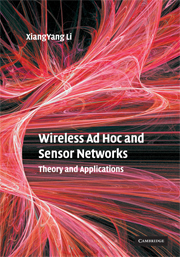Book contents
- Frontmatter
- Contents
- Preface
- Acknowledgments
- Abbreviations
- Part I Introduction
- Part II Wireless MACs
- 3 Wireless Medium-Access Control Protocols
- 4 TDMA Channel Assignment
- 5 Spectrum Channel Assignment
- 6 CDMA Code Channel Assignment
- Part III Topology Control and Clustering
- Part IV Wireless Network Routing Protocols
- Part V Other Issues
- Bibliography
- Index
6 - CDMA Code Channel Assignment
from Part II - Wireless MACs
Published online by Cambridge University Press: 06 July 2010
- Frontmatter
- Contents
- Preface
- Acknowledgments
- Abbreviations
- Part I Introduction
- Part II Wireless MACs
- 3 Wireless Medium-Access Control Protocols
- 4 TDMA Channel Assignment
- 5 Spectrum Channel Assignment
- 6 CDMA Code Channel Assignment
- Part III Topology Control and Clustering
- Part IV Wireless Network Routing Protocols
- Part V Other Issues
- Bibliography
- Index
Summary
Introduction
In Chapter 4, we basically studied how to assign time slots to links such that the simultaneous transmissions will be interference-free. In Chapter 5, we studied how to assign frequency channels to wireless terminals such that (1) they are interference-free; i.e., the spectrums assigned to nearby terminals will be disjoint; or (2) the links formed by the assigned channels will form a network with certain networking properties such as being connected. In this chapter, we study the channel assignment to wireless networks when the channels are defined by CDMA codes.
Code-division multiple access (CDMA) provides a higher capacity, flexibility, scalability, reliability, and security than conventional frequency-division multiple access (FDMA) and time-division multiple access (TDMA). It has already been widely deployed in 2G cellular communication systems and was proposed for the emerging and future wireless systems, including WLANs and wireless ad hoc networks. In a CDMA system, the communication channels are defined by pseudo-random codewords, which are carefully designed to cancel each other out as far as possible. Each communication utilizes the entire available spectrum, and every bit of data is multiplied by the codeword used by the communication channel. Thus, many duplicates of the same information are transmitted to ensure that at least one gets through. The number of duplicates, which is equal to the length of the codeword, is known as the spreading factor. The inverse of the length of the codeword is known as the rate of the codeword.
Information
- Type
- Chapter
- Information
- Wireless Ad Hoc and Sensor NetworksTheory and Applications, pp. 120 - 152Publisher: Cambridge University PressPrint publication year: 2008
